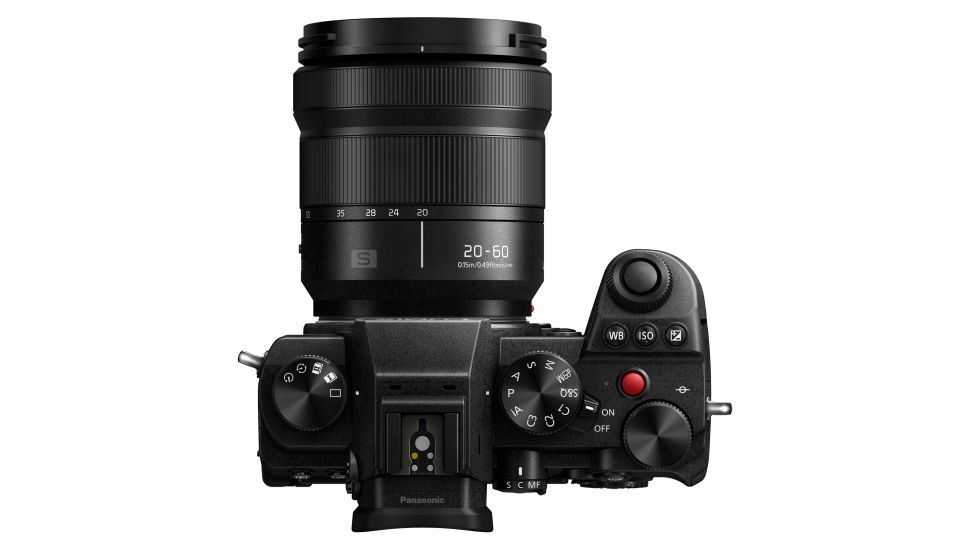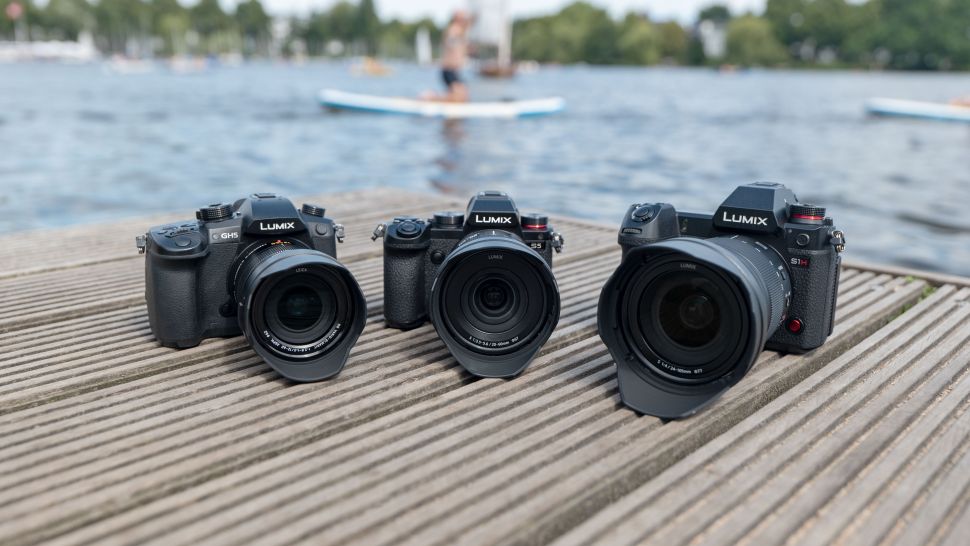The photograph below, courtesy of the Panasonic press office, provides a clear demonstration of the size of the new S5 relative to the company’s original full-frame cameras and the micro four-thirds flagship, the GH5. Although the new Sony Alpha 7C shrinks the full-frame body even further—it is no bigger nor heavier than the company’s APS-C cameras, the S5 is currently as svelte as it gets for full-frame L-Mount fans.
For me, this speaks louder than words and convinces me that the S5 has been worth waiting for. At first glance, it is tempting to finger the centre camera as the one with the smaller sensor. Not so, of course, while the smallest camera of this three is indeed the centre one but it has the same full-frame sensor as the S1.
BMI talk
The S5 looks more like the micro four-thirds G9 or, even, the earlier GX8. It has the body mass index of a quarter-size-sensor camera with the benefits of full-frame. In comparison, the S1R looks huge, and even the GH5 appears to be much bulkier than the S5.
For comparison purposes, the GH5 on the left weighs 725g. The S1R to the right is 1,020g while the new S5 is just 11g shy of the GH5 at 714g. Even the G9, which is smaller than the GH5, tips the scales at only 56g less than the new full-frame lightweight.
A glance at the top plate of the S5 explains how Panasonic has been able to shrink the body while housing the 24MP full-frame sensor. Gone is the large LCD status screen of the S1. Instead, we have a more traditional but comprehensive clutch of physical controls.
As you can see from the top plate (below), the camera provides physical dial access to drive mode and PASM settings. No pressing and twisting of programable dials as you have to do on most cameras these days. And there are clearly labelled buttons for focus mode (on the top of the camera but clearly visible from the top view), white balance, ISO and exposure compensation.
Back to basics
The downside of the lack of a top status screen is that we can’t view exposure settings, including speed and aperture at a glance, as you can with, say, the S1R or Leica SL2. But this is something I believe many buyers will not be concerned about.
They are likely to be more concerned by the small 2.36 million dot viewfinder which will come as a surprise to anyone used to the munificence of the Leica SL2 or Panasonic S1.
Yet it does have both 60 and 120 fps options and, while it certainly isn’t the panel that’s in the SL2 or S1, I cannot say that it really feels like a huge step-down because it is still a high-quality panel. The size of the panel was the norm until late 2018/early 2019 and there are many very popular and successful cameras (Sony A6600 comes to mind) featuring similar panels. It’s an area where we need to get to grips with the camera and make a balanced judgment.
Quite apart from the S5’s pretensions as a video and vlogging camera, it has the makings of a great stills camera for L-Mount addicts. It will open the way to smaller, lighter primes. Up to now, the size of the Leica and Panasonic full-frame mirrorless bodies has spawned a surfeit of very fast, very heavy lenses. This has been one of the major complaints levelled against the system: Huge lenses for huge cameras.
This works both ways, however. The bulk of the S1R or SL2 is better for handling lenses such as the Leica 24-90mm Vario-Elmarit or the Sigma 100-400mm f5-6.3 Contemporary DG DN OS. It’s horses for courses, and I think many L-Mount owners will regard the S5 as a second body for use with lighter lenses.
Small primes
There has been a demand for smaller lenses, even at the expense of maximum aperture, and the arrival of the S5 is sure to promote lens downsizing. Not everyone needs f/1.2 or f/1.4 except on occasion. Yet at the moment there is only one small full-frame lens for the L-Mount system and that is the Sigma 45mm f/2.8. I have used this extensively on the SL2 (and also on the CL, which it matches perfectly) and it is impressive for the relatively low price. Our regular contributor Narain Jashanmal has already received his S5 and confirms that the Sigma 45mm is a perfect match. And, as he points out, Panasonic has introduced a trio of relatively lightweight primes which have yet to reach the market.
It’s significant that Panasonic has chosen to add the Sigma to its launch promotion for the S5. The fact is, Panasonic doesn’t have anything small enough at the moment to complement the S5 other than the interesting and unique 20-60mm zoom. I cannot remember another instance of a major manufacturer offering a third-party lens as part of a launch promotion. This speaks volumes.
The S5 is a big step forward in widening the appeal of the L-Mount standard and I believe it will spawn some interesting lens developments over the next year or so.



The camera Leica should have released.
I agree, in addition to the SL2. There is hope, however. It would not take a great deal of fiddling to rebrand the S5 as an SL2 Lite. The gubbins of the SL2 is very similar to that of the S1R and it is believed that the electronics are all Panasonic. If you look carefully at the SL2, the basic outline is similar to that of the Panasonic S1. I think there would be a demand for such a camera and let’s keep our fingers crossed that Leica thinks so too.
How good is the combination with Leica M and R lenses? Any new information?
Don’t know yet. But I presume it will be exactly the same as the S1. Some Leica purists say that non-Leicas do not work as well as the CL or SL2 (or, it almost goes without saying) the M. But others are quite happy. I tend to fall into the latter camp. The one aspect of M lens use on Leicas is the convenience of built-in lens profiles. One thing for certain, though, and that is the size and weight of M lenses will suit the S5.
Hi Andreas – and great article Mike.
I did lots of comparisons between the SL and the S1 for M and R lenses, and felt that whilst technically the Panasonic did quite well, the lack of profiles for vignetting and colour cast, the softer corners and the lack of Exif information meant that you were better off shooting with an SL or SL2.
Which is no criticism of the Panasonic cameras (they’re great) Just that Leica put a lot of effort into making their L mount cameras work well with M and R lenses, including 6 bit coding recognition, lens profiles, thinner coverglass on the sensor, aperture estimations etc. No good reason why Panasonic should do that. and of course they haven’t.
tempting but just too big for me. Why don’t they develop a small 35mm f2.8 like the zeiss sonnar? I’ve read the lens road map and it seems to be f1.8 for the 3 lenses they plan to develop (bigger!). For the short time I used the sony zeiss it had great bokeh wide open if you got close.
Well I suppose the obvious reason is autofocus. No modern AF lens seems to be as small as, say, the 35mm Summicron of the Sonnar. In a way, that’s a lot of the magic of the M system.
Looks great, here in US LENS DEAL only good till September 30. Don’t know why but that on BandH site.
Yes, it’s the same here and a problem since the cameras and kits are not yet available in many stores. I am assured by my supplier that the order in September is the crucial thing. But you need the camera serial number in order to make the claim. I need to check.
With the deadline coming closer, S5 bodies and kits seem the be available in larger quantities. My dealer, Lichtblick at Constance in South Germany, has both on stock in sufficient quantities. That is, one less than before, because one of the kits made its way into my bag somehow. I will use it for reportage work on assignments when an M is not so suitable. Of course, I am happy to share my experience as soon as I can give a decent account. What I can say for sure already now: The 20-60 is a perfect zoom range for professional news photography even with its moderate aperture. Some tests with M lenses will follow as soon as I find the time.